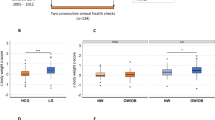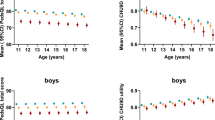Abstract
Background
Overweight and obesity in children is associated with poor health-related quality of life (HRQoL), but the nuances of this relationship across different age and socio-demographic groups are not well-established. The aim of this study is to examine how the association between weight status and HRQoL changes with age and socioeconomic position (SEP) throughout childhood and adolescence.
Methods
We used data from the Longitudinal Study of Australian Children (LSAC), a cohort study in which children were interviewed biennially from ages 4 to 17 years over seven waves of data. Measurements of HRQoL (using PedsQLTM), body mass index (BMI), and socio-demographic characteristics were collected at each interview. Of the 4983 children recruited into the study, we included data from 4083 children (a total of 24,446 observations). We used generalised estimating equations to assess whether age and SEP modified the association between weight status and HRQoL, after controlling for sex, long-term medical condition, language spoken to child and maternal smoking status.
Results
Age was a significant modifier of the association between weight status and HRQoL, with adjustment for known predictors of HRQoL (P < 0.001). At age 4, children with obesity had, on average, a 0.99 (95% CI 0.02–1.96) point lower PedsQL total score than children at healthy weight. This difference became clinically important by age 9 at 4.50 (95% CI 3.86–5.13) points and increased to 6.69 (95% CI 5.74–7.64) points by age 17. There was no evidence that SEP modified the relationship between weight status and HRQoL (P > 0.05).
Conclusions
Our results demonstrate that the relationship between overweight and obesity status and poor HRQoL is strengthened with increasing age through childhood and adolescence, but is not affected by SEP. Paediatricians, researchers and carers of children with obesity should acknowledge HRQoL outcomes, particularly for older children and adolescents.
This is a preview of subscription content, access via your institution
Access options
Subscribe to this journal
Receive 12 print issues and online access
$259.00 per year
only $21.58 per issue
Buy this article
- Purchase on Springer Link
- Instant access to full article PDF
Prices may be subject to local taxes which are calculated during checkout


Similar content being viewed by others
Code availability
The data from LSAC used in this study is available by application to the data custodians: Department of Social Services, Australian Government. The code to analyse these data, based in STATA version 15.0, are available by request to the corresponding author.
References
Schwimmer JB, Burwinkle TM, Varni JW. Health-related quality of life of severely obese children and adolescents. JAMA. 2003;289:1813–9.
Williams J, Wake M, Hesketh K, Maher E, Waters E. Health-related quality of life of overweight and obese children. JAMA. 2005;293:70–6.
Jansen PW, Mensah FK, Clifford S, Nicholson JM, Wake M. Bidirectional associations between overweight and health-related quality of life from 4–11 years: longitudinal study of Australian children. Int J Obesity. 2013;37:1307–13.
Ul-Haq Z, Mackay DF, Fenwick E, Pell JP. Meta-analysis of the association between body mass index and health-related quality of life among children and adolescents, assessed using the pediatric quality of life inventory index. J Pediatr. 2013;162:280–6.e1.
Tsiros MD, Olds T, Buckley JD, Grimshaw P, Brennan L, Walkley J, et al. Health-related quality of life in obese children and adolescents. Int J Obesity. 2009;33:387.
Wake M, Clifford S, Patton G, Waters E, Williams J, Canterford L, et al. Morbidity patterns among the underweight, overweight and obese between 2 and 18 years: population-based cross-sectional analyses. Int J Obesity. 2013;37:86.
Wille N, Bullinger M, Holl R, Hoffmeister U, Mann R, Goldapp C, et al. Health-related quality of life in overweight and obese youths: results of a multicenter study. Health Qual Life Outcomes. 2010;8:36.
Minet Kinge J, Morris S. Socioeconomic variation in the impact of obesity on health-related quality of life. Social Sci Med. 2010;71:1864–71.
Soloff C, Lawrence D, Johnstone R. LSAC technical paper no. 1: Sample design. Melbourne, Australia: Australian Institute of Family Studies; 2005.
Varni JW, Burwinkle TM, Seid M, Skarr D. The PedsQL™* 4.0 as a pediatric population health measure: feasibility, reliability, and validity. Ambul Pediatr. 2003;3:329–41.
Australian Institute of Family Studies. Longitudinal study of Australian children data user guide–November 2015. Melbourne: Australian Institute of Family Studies; 2015.
Australian Institute of Family Studies. The longitudinal study of Australian children: an Australian government initiative data user guide–December 2018. Melbourne: Australian Bureau of Statistics, Department of Social Services, AIFS; 2018.
World Health Organization. Child growth standards. Geneva, Switzerland: WHO; 2019. https://www.who.int/childgrowth/standards/bmi_for_age/en/.
World Health Organization. Growth reference 5–19 years. Geneva, Switzerland: WHO; 2019. https://www.who.int/growthref/who2007_bmi_for_age/en/.
Baker K, Sipthorp M, Edwards B A Longitudinal Measure of Socioeconomic Position in LSAC: Australian Institute of Family Studies; 2017.
Vella SA, Magee CA, Cliff DP. Trajectories and predictors of health-related quality of life during childhood. J Pediatr. 2015;167:422–7.
Varni JW, Limbers CA, Burwinkle TM. Impaired health-related quality of life in children and adolescents with chronic conditions: a comparative analysis of 10 disease clusters and 33 disease categories/severities utilizing the PedsQL™ 4.0 generic core scales. Health Qual Life Outcomes. 2007;5:43.
Ziegler A, Kastner C, Blettner M. The generalised estimating equations: an annotated bibliography. Biom J. 1998;40:115–39.
Ghisletta P, Spini D. An introduction to generalized estimating equations and an application to assess selectivity effects in a longitudinal study on very old individuals. J Educ Behav Stat. 2004;29:421–37.
Centers for Disease Control and Prevention. Defining childhood obesity USA: CDC; 2018. https://www.cdc.gov/obesity/childhood/defining.html.
Usback S, Australian Bureau of Statistics. The longitudinal study of Australian children: LSAC technical paper no. 20, Wave 7 weighting and non-response. Canberra, Australia: Commonwealth of Australia, Department of Social Services; 2018.
Australian Institute of Health and Welfare. Childhood overweight and obesity. Canberra: AIHW; 2014.
Von Rueden U, Gosch A, Rajmil L, Bisegger C, Ravens-Sieberer U. Socioeconomic determinants of health related quality of life in childhood and adolescence: results from a European study. J Epidemiol Community Health. 2006;60:130–5.
Eminson K, Canaway A, Adab P, Lancashire E, Pallan M, Frew E. How does age affect the relationship between weight and health utility during the middle years of childhood? Qual Life Res. 2018;27:1455–62.
Tan EJ, Brown V, Petrou S, D’Souza M, Moodie ML, Wen LM, et al. Is there an association between early weight status and utility-based health-related quality of life in young children? Qual Life Res. 2018;27:2851–8.
Lima RA, Bugge A, Pfeiffer KA, Andersen LB. Tracking of gross motor coordination from childhood into adolescence. Res Q Exerc Sport. 2017;88:52–9.
Greier K, Drenowatz C. Bidirectional association between weight status and motor skills in adolescents: a 4-year longitudinal study. Wien Klin Wochenschr. 2018;130:314–20.
Falkner NH, Neumark‐Sztainer D, Story M, Jeffery RW, Beuhring T, Resnick MD. Social, educational, and psychological correlates of weight status in adolescents. Obesity Res. 2001;9:32–42.
Griffiths LJ, Page AS. The impact of weight‐related victimization on peer relationships: the female adolescent perspective. Obesity. 2008;16:S39–S45.
Gibson LY, Allen KL, Davis E, Blair E, Zubrick SR, Byrne SM. The psychosocial burden of childhood overweight and obesity: evidence for persisting difficulties in boys and girls. Eur J Pediatr. 2017;176:925–33.
Acknowledgements
We thank the Department of Social Services, Australian Government for providing access to data collected from LSAC. We also thank the funding bodies that support our research.
Funding
AK is supported by the Kassulke Scholarship and the National Health and Medical Research Council (NHMRC) Scholarship (APP1169039) for PhD study. TL is supported by an NHMRC Early Career Fellowship (APP1141392) and a Heart Foundation Postdoctoral Fellowship (award ID 101956). EJT is supported by the NHMRC Centre of Research Excellence in Early prevention of Obesity in Childhood (APP1101675).
Author information
Authors and Affiliations
Corresponding author
Ethics declarations
Conflict of interest
The authors declare that they have no conflict of interest.
Additional information
Publisher’s note Springer Nature remains neutral with regard to jurisdictional claims in published maps and institutional affiliations.
Supplementary information
Rights and permissions
About this article
Cite this article
Killedar, A., Lung, T., Petrou, S. et al. Weight status and health-related quality of life during childhood and adolescence: effects of age and socioeconomic position. Int J Obes 44, 637–645 (2020). https://doi.org/10.1038/s41366-020-0529-3
Received:
Revised:
Accepted:
Published:
Issue Date:
DOI: https://doi.org/10.1038/s41366-020-0529-3
This article is cited by
-
Health-related quality of life in children under treatment for overweight, obesity or severe obesity: a cross-sectional study in the Netherlands
BMC Pediatrics (2023)
-
Reliability, acceptability, validity and responsiveness of the CHU9D and PedsQL in the measurement of quality of life in children and adolescents with overweight and obesity
International Journal of Obesity (2023)
-
Quality of life and psychosocial outcomes among children with metabolically healthy and unhealthy obesity
Pediatric Research (2023)
-
Psychometric Evaluation of the PedsQL GCS and CHU9D in Australian Children and Adolescents with Common Chronic Health Conditions
Applied Health Economics and Health Policy (2023)
-
Comparing the Mediating Effect of Adolescent Lifestyle Profiles on the Relationship between Smartphone Addiction and Health-related Quality of Life Among Male and Female Senior High School Students in the Philippines
International Journal of Mental Health and Addiction (2023)



